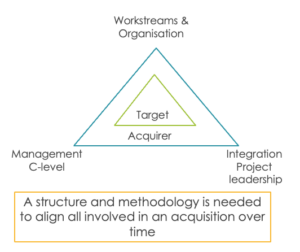Maximizing Value in Mergers: Crafting a Unified Path for Success
Michael Holm
In the dynamic landscape of post-merger integration, a critical challenge is harmonizing stakeholders across acquiring and target companies. This encompasses C-level executives, middle management, employees, functional teams, and the integration project itself. The key to achieving seamless integration lies in the establishment of a robust structure and methodology.
Key Areas of Focus in Post-Merger Integration:
- Integration Governance and Project Setup:
- Define the governance structure and set up the integration project for success.
- Communication During Year 1:
- Establish effective communication channels to bridge the gap between stakeholders during the crucial first year.
- Strategy Alignment and Execution:
- Ensure alignment between the overarching strategy and its execution within the integrated entities.
- PMI Objectives & Synergy Implementation:
- Clearly outline post-merger integration objectives and execute strategies to realize synergies.
- Alignment on Key Integration Action Items:
- Foster alignment among all parties involved on critical integration action items.
- Agreement on End-State Operating Model:
- Define and secure agreement on the ultimate operating model post-integration.
Structural Alignment Among Six Key Stakeholder Groups:
(See the accompanying diagram for a visual representation.)

Supporting Methodology for Seamless Integration:
- Logical Way-of-Working:
- Establish a logical progression from deal rationale down to individual tasks.
- Common Terminology:
- Implement consistent terminology across all facets of post-merger integration.
- Understanding the Integration Journey:
- Provide a comprehensive understanding of the integration journey over the course of 1-2 years.
- End-to-End Holistic Approach:
- Foster a holistic approach spanning from customer lead to delivery for a unified organizational perspective.
- Feedback Loops for Adaptation:
- Incorporate feedback loops to dynamically adjust to evolving circumstances on the ground.
- Agility in Response to Market Changes:
- Cultivate agility to adapt seamlessly to shifts in market dynamics and the business environment.
- Choosing Management Approach:
- Provide flexibility in adopting either a management-by-objectives or a task-oriented approach based on organizational needs.
Collaborative Framework:
Success in post-merger integration is achieved when acquiring and target companies collaboratively establish the structure and methodology immediately after signing. This joint effort ensures a unified approach, setting the stage for a successful integration journey.
Michael Holm has been a Partner for 13 years at Global PMI Partners covering Nordics, Baltics, Poland and DACH, a specialist consulting firm supporting our listed company and private equity clients with their inorganic growth strategies and M&A integrations and divestments around the world. We provide expert, on-demand M&A services and resources, leveraging our market leading M&A approach & methodology.
With a track record of over 500 operational due diligence, acquisition integration, divestment, carve out and growth projects Global PMI Partners is with 350+ consultants primarily in Europe and US adept at helping our clients achieve the desired value from both acquisition and divestment strategies.









